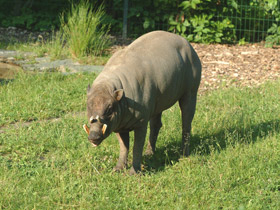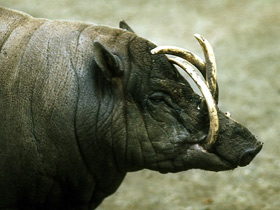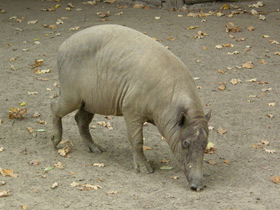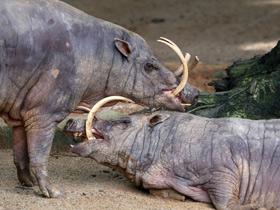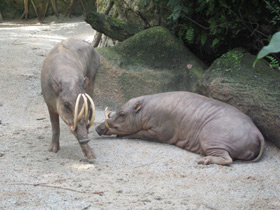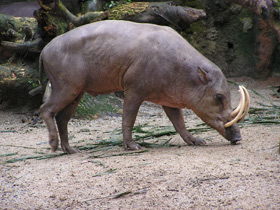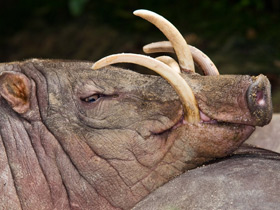The Buru babirusa or hairy babirusa Babyrousa babyrussa
Buru babirusa видео
The morphology of this amazing pig is so special that some zoologists have found it logical to treat the Buru babirusa as separate subfamily. The Buru babirusa is quite a large animal, with body length of about 1 m, height at the shoulders, 80 cm, and weight reaching 90 kg. The appearance of this pig is very unusual and not typical for the Suidae family; it has rounded body, relatively small head, quite long legs, and small nasal disc. The skin has large folds of wrinkles, and the coat is gray, sometimes with brownish or pink tints, covered with sparse hair. Some subspecies may even look naked. The only decorating feature is yellowish bristly crest along this pig’s spine, and small tail tuft. The babirusa's most dramatic physical features are its huge lower and upper tusks that may be incredibly long in the males. The upper canines grow upward, pierce through the lower jaw and curve backward toward the forehead, growing into the forehead with their tips in the old males. It is unclear why the babirusas need such strange tusks. While scientists are trying to solve this mystery, local people believe that the babirusas use their tusks for holding on tree branches which helps them to keep balance when they are sleeping in standing position.
These exotic pigs occur in Sula Islands and on Buru in Indonesia, inhabiting marshy forests and reed thickets. The babirusas are good swimmers and can swim through wide rivers and even small sea gulfs. These animals enjoy staying in water in the hot time of the day, but unlike other pigs, they prefer clean water to muddy paddles. The babirusas have more complex digestive systems than other pigs; they have two-chambered stomachs with symbiotic bacteria which allow them to digest fibber through microbial fermentation. That’s why the babirusas’s diet is based mostly on the foliage and grass, and because of this, local people call them “deer pigs” (exact translation of the local word “babirusa”). However, the babirusas living on Buru use different sources of food: they often come to the sea coast in the periods of low tides and collect edible small sea animals and plants products left on the sand. These pigs are solitary or live in small family groups. Gestation in females lasts from 125 to 150 days and results in the birth of one or two piglets; it is interesting that the two newborns are always of the same sex. Young babirusas are weaned at one month of age, when they start foraging on their own. The babirusas are becoming increasingly rare because of poaching, and logging activities.


















